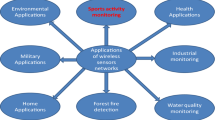Abstract
The javelin is one of the well-received track and field events, which are available from the origin of the human race. The people from the old civilization used the spear-like structure for hunting animals and a soldier to kill enemies in the Warfield used later spear. Due to the development of the human race, the skill of throwing spear was added to the sports category. It is named as Javelin, and all countries play it over the world. The ultimate goal of Javelin throw is to throw a javelin with exposed hands with the highest force so that it will achieve the maximum distance in a given area. Several factors need to be considered for playing this game effectively, they are physiological parameters, a movement (or) release parameters, and injury parameters of javelin athletes. In the proposed work, we design a device, which is used to measure the movement, or release parameters of a javelin by using various sensors and these measured parameters are sent to a cloud server with the help of Wi-Fi device for maintaining a database. The coach or athlete can view the release parameters of javelin such as the angle of release, the height of release and speed of release in real-time through the application called Real-Time Sports Training for Javelin Athletes (ROSOTO-JAV). By monitoring and analyzing, certain throw and provide auto feedback to the athlete along with their parameters to improve their performance in future using the IoT technology.


















Similar content being viewed by others
Change history
30 May 2022
This article has been retracted. Please see the Retraction Notice for more detail: https://doi.org/10.1007/s12652-022-03992-w
References
Aazam M, Huh EN (2014) Fog computing and smart gateway based communication for the cloud of things. In: The future internet of things and cloud (FiCloud), 2014 international conference on. IEEE, pp 464–470
Alkar AZ, Buhur U (2005) An Internet-based wireless home automation system for multifunctional devices. IEEE Trans Consum Electron 51(4):1169–1174
Baker T, Asim M, Tawfik H, Aldawsari B, Buyya R (2017) An energy-aware service composition algorithm for multiple cloud-based IoT applications. J Netw Comput Appl 89:96–108
Bartonietz K (2000) Javelin throwing: an approach to performance development. Biomech Sport Perform Enhancement Inj Prev 9:401–434
Best RJ, Bartlett RM, Morriss CJ (1993) A three-dimensional analysis of javelin throwing technique. J Sports Sci 11(4):315–328
Bhuiyan MZA, Wang G, Wu J, Cao J, Liu X, Wang T (2017) Dependable structural health monitoring using wireless sensor networks. IEEE Trans Depend Secure Comput 14(4):363–376
Burger EW, Frieder O (2007) Efficient residential consumer device interaction with network services. IEEE Trans Consum Electron 53(1):100–107
Colak I, Demirbas S, Sefa I, Irmak E, Kahraman HT (2008) Remote controlling and monitoring of HVAC system over the internet. J Sci Ind Res 67:680-684
Fang H, Fang K (2010) The design of the remote embedded monitoring system based on the Internet. In: Measuring technology and mechatronics automation (ICMTMA), 2010 international conference on, vol 3. IEEE, pp 852–854
He W, Yan G, Da Xu L (2014) Developing vehicular data cloud services in the IoT environment. IEEE Trans Ind Inf 10(2):1587–1595
Islam SR, Kwak D, Kabir MH, Hossain M, Kwak KS (2015) The Internet of things for health care: a comprehensive survey. IEEE Access 3:678–708
Kelly SDT, Suryadevara NK, Mukhopadhyay SC (2013) Towards the implementation of IoT for environmental condition monitoring in homes. IEEE Sens J 13(10):3846–3853
Lai YS, Wang J, Lin ZQ, Wang MH, Tien SC (2002) Internet-based monitoring and control of fuzzy-controlled inverter system. In: IECON 02 [Industrial Electronics Society, IEEE 2002 28th annual conference of the], vol 3. IEEE, pp 2365–2370
Linthorne NP (2006) Throwing and jumping for the maximum horizontal range. arXiv preprint physics/0601148
Pan J, Jain R, Paul S, Vu T, Saifullah A, Sha M (2015) An internet of things framework for smart energy in buildings: designs, prototype, and experiments. IEEE Internet Things J 2(6):527–537
Sakthipriya N (2014) An effective method for crop monitoring using wireless sensor network. Middle-East J Sci Res 20(9):1127–1132
Wang C, Bi Z, Da Xu L (2014) IoT and cloud computing in automation of assembly modeling systems. IEEE Trans Ind Inf 10(2):1426–1434
Yang Z, Zhou Q, Lei L, Zheng K, Xiang W (2016) An IoT-cloud based wearable ECG monitoring system for smart healthcare. J Med Syst 40(12):286
Zhou J, Leppanen T, Harjula E, Ylianttila M, Ojala T, Yu C, Yang LT (2013) Cloud things: a common architecture for integrating the Internet of things with cloud computing. In: Computer supported cooperative work in design (CSCWD), 2013 IEEE 17th international conference on. IEEE, pp 651–657
Zhu Z, Cui R (2007) A remote intelligent monitoring system based on embedded internet technology. In: Automation and logistics, 2007 IEEE international conference on. IEEE, pp 2665–2669
Author information
Authors and Affiliations
Corresponding author
Additional information
Publisher's Note
Springer Nature remains neutral with regard to jurisdictional claims in published maps and institutional affiliations.
This article has been retracted. Please see the retraction notice for more detail: https://doi.org/10.1007/s12652-022-03992-w
About this article
Cite this article
Elumalai, G., Ramakrishnan, R. RETRACTED ARTICLE: Development of novel and efficient approach for analyzing and monitoring the movement parameters for javelin athletes based on internet of things. J Ambient Intell Human Comput 12, 4663–4676 (2021). https://doi.org/10.1007/s12652-020-01863-w
Received:
Accepted:
Published:
Issue Date:
DOI: https://doi.org/10.1007/s12652-020-01863-w




